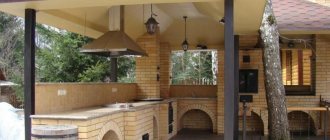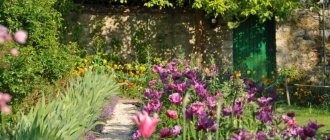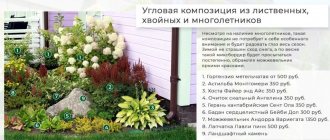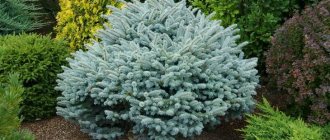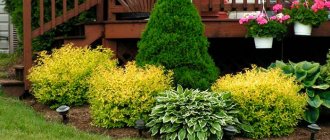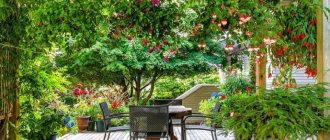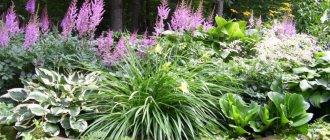Coniferous plants are among the most popular and in demand in landscape design. Evergreens are always in trend, since the hassle with them is minimal, but the charm of such framing of the territory is indescribable. Despite this, many gardeners strive to supplement the area with conifers and other plants so that the area has a holistic picture and a fragrant appearance at any time of the year. What and how is combined with conifers? Let's find out how connoisseurs of acidic soil interact with the rest of the plant world.
Conifers and lawn grass: a good or bad combination?
Many are sure that lawn grass can be an ideal neighbor for conifers, since it does not flower, so shades of greenery will harmonize well in tandem. In fact, conifers do not welcome the lawn. The thing is that by their nature these plants are completely different. Thus, a lawn is a relative of cereal crops that grow in fields and steppes, while conifers are more aggressive forest dwellers and therefore need to be differentiated. Some experts argue that the danger is that each type of plant has its own microorganisms that find it very difficult to coexist nearby. It is these microorganisms that cause a completely different level of acidity under these plants - conifers prefer an acidic environment, but the lawn does not, which is why the “misunderstanding” occurs.
Conclusion, a lawn under conifers is a bad idea, since different levels of acidity will significantly interfere with the development of the root system of both the conifer and the lawn.
Coniferous color combinations
Coniferous plants can vary significantly in color. If you are going to assemble plants into a composition, you need to pay attention to the color of the needles so that a unique range is formed:
- If a composition includes three components, then only two colors can be present in it.
- A five-element composition should consist of no more than three different colors.
- If there are 25 or even more elements in the composition, they must be combined into groups of three, and plants in one group should be selected according to a single color characteristic.
Only in this case will coniferous plants form an ensemble in which they will look harmonious, without violating the integrity of the picture.
Material on the rules for designing group and solitary plantings of decorative conifers will also be useful:
Numerous colors and shades of pine needles can create harmonious combinations if you take care in advance of their compatibility with each other
Conifers with a green “carpet” at the foot - there is an alternative to the lawn
Despite the fact that the lawn does not react very favorably to planting under evergreen conifers, this does not make it any easier for gardeners, since the desire to supplement the base with greenery remains. There is a way out - to grow wood sorrel at the foot of the conifers. The thing is that the plants do not have a conflict of interest, since both conifers and wood sorrel are forest dwellers, and this carpet of greenery has absolutely no additional lighting requirements, accordingly, the natural shadow from the trees is not an obstacle to active growth.
In addition to the fact that wood sorrel has attractive greenery, it is also able to please with massive snow-white flowering, which starts in early spring. Not only flowering gives charm to sorrel, but also a huge palette of varieties and varieties. You can choose between the appearance of the plant, since not only bright greens represent sorrel, but also more emerald shades, you can also find varieties with distinct inclusions, or not green at all, but a reddish shade, where you can also see a brown color.
The only nuance in the tandem of conifers and wood sorrel is the fact that you can’t trample or walk on wood sorrel, as this ornamental plant gets injured very quickly.
Roses and thujas - how to beat the combination of roses and conifers
Thanks to conifers, the garden looks especially advantageous, because when the rose nurseries fade, coniferous trees complement the picture and the garden remains evergreen. A correctly selected tree crown, growth and shape of conifers give the garden a special charm. With the help of coniferous trees it is possible to create any design suitable for buildings on the site.
Which conifers go best with roses?
It is believed that the combination with thuja occidentalis is ideal, since it does not interfere with the development of the rose's root system and does not extinguish the rose, allowing it to gain strength and bloom every year.
Roses develop well with vertical conifers. These include: emerald, brabant, and spherical thujas. The main thing is that the thujas do not grow wider, as in this case they will cover the rose bushes. Of the junipers, the following varieties are well suited: Blue Arrow, Moonglow, Sky rocket.
Fig. 1 Only roses and conifers, no other plants, the composition in the opinion of the site’s editors is magnificent, nothing superfluous (photo from the site wcb.ru)
Fig.2 Diluted with deciduous trees, shrubs and summer trees (photo from wcb.ru)
For planting, you need to choose less aggressive conifers so that over time they do not crowd out rose bushes. Aggressive conifers and junipers are considered to be: Blue Alps, Blue Carpet, Gray Owl, Blue Danuba.
Before planting, be sure to outline the goal of what you want to get from the composition, highlight the roses, or simply close the empty space . From this you should base yourself on which conifer to choose for planting on the site: spherical or growing upward.
The combination of roses and thujas - is such a neighborhood possible?
Thujas can be planted next to roses, but at a distance of one and a half meters, since the root system of thujas grows quickly, and it can destroy the rose. If the rose has been growing on the site for more than five years, then you can safely plant thujas, since the root system of the rose is already stable and nothing will interfere with it.
Photo source - www.thegracefulgardener.com
According to information from the rosebook.ru forum, it is not recommended to plant asparagus with roses, as it inhibits the root system and the roses become invisible. And also, according to the notes of a forum user, the planted squash inhibits growth and when it was dug up, the rose began to grow. It is not recommended to plant cloves and other cereals, lilies .
Forum members agreed that the rose loves freedom and is best grown separately from everything else.
Thuja is unpretentious and grows in almost any conditions: in well-lit places or partial shade, but does not like very dark and northern places. To grow a fence, use the Columna variety; thujas grow into a beautiful hedge.
To create a beautiful hedge, you should find out in advance how much the selected variety grows upward and in width; planting depends on this, so that the hedge remains beautiful even over several years.
The Smaragd variety is also excellent for creating a hedge. The distance when planting each plant is 70 cm. It should be planted a meter or one and a half meters from the fence. In three years, the thuja grows into a tall, beautiful hedge.
Thuja western emerald has a regular cone-shaped crown, reaching up to 4-6 meters in height and up to 1.80 in width. This thuja is always evergreen. Grows in any soil, grows best in the sun. The soil should be moist and fertile. Already fertilized seedlings are planted in the ground.
Hardy and frost-resistant. The good quality of this variety is that it does not turn yellow.
Thuja is suitable for planting together with roses. But we must take into account the rule of constructing an ensemble. If three elements are involved in planting, then the ensemble should combine no more than two colors. So, the constructed composition will look organic. If there are more colors, then the elements are combined into groups of three with the same colors.
Photo source - russcletta.com. The author is landscape designer from Italy Russ Cletta. Roses are given the foreground, conifers serve as the background.
The use of roses and conifers in landscape design is possible, but a large area must be allocated for this.
Due to the extensive root system of both plants, they are planted at a distance of at least one and a half meters - this promotes the further development of the plants.
It is recommended to plant thujas in a semi-shaded area, and roses in lighter and more formal areas. The rose will not look great if planted in the shade.
Is it possible to plant roses between thujas along the fence?
Photo source - davesgarden.com, rose variety - "Iceberg". An example of a very beautiful successful combination of roses and thujas along the fence.
First of all, the rule is that coniferous trees should be planted at a distance of 1.5 meters from the fence, since when they grow, they can damage the installed fence. Developing a composition where thujas and roses are combined looks very beautiful, but requires constant care. Plants must be pruned in a timely manner and their growth monitored.
When planting, thujas are planted closer to the fence (albeit at an acceptable distance), since they create the main fence, and roses are planted at a distance of one and a half meters in another trench. For planting, it is advisable to use ready-made, proven seedlings.
The next rule is timely watering so that the root system is established and does not dry out. When composing the composition, you can plant tea roses, although in both of our examples we used varieties of climbing roses and planted them in the background.
Photo from the site zs-z.ru. A climbing rose is planted along the fence, a thuja is planted at a distance of a meter and a hosta is planted below, which completes and shades the composition.
In general, there are no obstacles to planting roses and thujas along the fence, but you should keep in mind: the proximity of these plants will require a lot of space. And pay attention to the height of the fence. It is no coincidence that in both our examples it is very tall.
In order to plant a coniferous flowerbed in landscape design, use this composition:
- A flowerbed with a lawn or a flowerbed in the form of a slide is taken as a basis;
- The decor can be stones or bark;
- Low-growing varieties of conifers are considered priority;
Source - dacha-vprok.ru
- The first composition features the Globosa variety;
- Number two is Selena;
- In the center, number three, is a cedar pine;
- At number four, Tsuga Canadensis is planted;
- At number five, junipers, variety Tamariscifolia, are planted;
- Number six, a pine tree, the variety Pinus sylvestris, is planted.
Scheme from the site dacha-vprok.ru
How to create a mixborder?
Mixborder is the creation of a flower bed in groups, where each group of plants smoothly flows into another. The flowerbed consists of three stages:
- Three-dimensional plants are planted in the background;
- Tall plants;
- Plants without lush foliage.
Next, ground-blooded roses and annual plants are planted. Decorated with stones. For a mixborder, choose a sunny or slightly shaded place.
https://www.youtube.com/watch?v=7IyLnW_4hz8
Source - landas.ru
Flowering perennial plants planted in front of the thuja will look especially advantageous; creeping thuja or horizontal juniper are planted at the very bottom of the composition.
Flowerbed with roses and conifers (diagram):
Rice. from the site idei-dlja-dachi.com
- The Winchester Cathedral rose variety is planted;
- Rose variety Lady Emma Hamilton;
- Molineux;
- William Shakespeare;
- Evergreen juniper;
- Sage is planted along the edges of the flower bed;
- Ornamental hosta plant.
In this composition, juniper will highlight the roses and make them stand out from the background of the entire flowerbed. Sage helps light varieties of roses look good. If the sage grows, it can be formed into any shape. Hosta, planted along the edge of the flowerbed, complements the created composition.
Best neighbors for roses
The material presented in the video is quite controversial. Do the cultures suggested by the authors really look good with roses? And does everyone like this kind of garden-thicket?
Source: https://1decor.org/rasteniya/kustarniki/rozy-i-tui-sochetanie-roz-i-xvojnikov.html
Tandem of conifers and rhododendrons
Rhododendrons are considered the most ideal option for a neighborhood with coniferous trees, since these are the ornamental flowering plants that prefer acidic soil, so the environment of the evergreen beauties will be just right. Pine trees have spreading, but at the same time openwork shade, which allows them to not completely block the sun's rays. This lighting is quite enough for rhododendrons. Conifers have one practical feature - they significantly dry out the soil. Of course, in the summer it is necessary to water the plantings, but in the fall and early spring it is thanks to conifers that rhododendrons feel great, since the rainy season and thaw are not a hindrance to them, since the soil will have quite acceptable moisture, and not its excess.
Correct formation of the front garden
Beginner gardeners make the mistake of planting trees too densely. It should be remembered that conifers can grow in one area for 30-50 years. During this period, they grow and cover most of the area. So before planting, you need to calculate how tall the tree can grow, and then determine how much space it needs before the fence or house.
Coniferous plants. (Photo used under standard license ©ogorodnye-shpargalki.ru)
The simplest option is to create a flower bed from medium and small shrubs. This makes it easier to decide on the composition and arrangement of plants. For example, in the middle there is a main pyramidal shrub. Next to it you can plant lower crops, these include: mountain pine, thuja, European spruce. Flowers, barberries, low-growing conifers, and ground cover crops are planted in the resulting voids.
The flowerbed can be decorated with decorative pebbles, various flowers and ferns. You can build a gazebo near the flowerbed and create a wonderful place to relax.
Decorative and ornamental flowering plants and conifers - an attractive and harmonious tandem
Not only greenery successfully complements evergreens, but also bright, fragrant flowers that are able to delight with their beauty, despite the tests of shadow, soil composition and special neighbors. Often you can safely plant:
- rose hip;
- park roses;
- red elderberry;
- irgu;
- bergenia;
- fern;
- girl's grapes
Growing perennials near conifers
Not only rhododendrons can become excellent neighbors for coniferous trees, since an unusual environment, a light shady area, can be liked by no less bright and very beautiful perennials. Feel free to combine coniferous plants with roses and hydrangeas, thyme and heather, phlox and Erica. You can also aim for something more massive - barberry, fieldfare and dwarf varieties of birch.
Rules for planting coniferous plants in the ground
So, the basic rules by which conifers are planted include the following:
. The flower bed is ideal for large spaces and is usually located in areas adjacent to fences. In this composition, 2 varieties of common juniper are planted along the fence, and in front of them is a western thuja, on its sides there are junipers, in the middle there is mountain pine, barberry and again juniper, but now scaly, and then along the edge - horizontal juniper of 2 species;
dachadesign.ru
A lawn and an alpine slide serve as the base for the flower bed;
Arranging a flower bed of coniferous plants:
Patios located on several tiers of terraces look impressive. In this option, coniferous plants can delimit these zones: it is best to place tall trees on the upper level, and dwarf thuja species or creeping shrubs on the lower level:
Alternative to conifers and plants
The reality is that even the most interesting and successful tandems and combinations of conifers with ornamental or ornamental flowering plants cannot always be crowned with a successful growing season; significant “conflicts” and problematic situations may arise during the very growth of “neighbors”. In this case, you have to choose. Often the choice falls on conifers, so the question remains as to what to combine them with on the site. There are two options that will definitely be successful in solving this problem - creating compositions from scrap materials at the foot or building a mini pond.
As for structures , it can be anything, from rock gardens, rock gardens and stone structures, to primitive driftwood that can be varnished, interestingly decorated, or simply presented in a favorable light. This composition can be an excellent decoration option that everyone will definitely like.
The presence of a mini-reservoir on a site is a popular trend, which always harmonizes appropriately not only with conifers, but also in any landscape design. To make an artificial pond a truly beautiful addition, you can transform it with plants that can combine well with coniferous trees. These are fern, astilbe and hosta. These bright representatives are able to significantly transform the area, as well as highlight the conifers in the most advantageous light.
Coniferous plants in themselves are very beautiful, but they look very attractive in tandem with other plants, so you should not stop exclusively at evergreens, since the severity of conifers can be diluted with the bright colors of ornamental flowering and other plants.
What to plant next to coniferous plants?
Nowadays there is practically nowhere without conifers. Thanks to their diversity and unpretentiousness, they have firmly taken a place in our hearts and gardens. They are used everywhere in large and small groups and flower beds. With their help, the volume, height and depth of mixborders (its structure) are set. But, despite all their splendor, you will want to get rid of the monotony and add bright colors to your flower garden. What kind of perennial garden plants can be planted next to your favorite conifers? After all, being in such a neighborhood, they will have to endure varying degrees of shading, acidic soil, and insufficient or, conversely, excess moisture. Choose the same perennials for your neighborhood with architectural conifers - the neighborhood must be worthy. Plants should emphasize and support each other. Inexpressive plants that quickly fade and lose their appearance will look simply untidy against the background of conifers.
Discuss the video
In the background, you can use types of perennials that will not get lost and will easily cover the empty spaces between the main plants with their monumental appearance and height. Such perennials form dense clumps and are decorative in themselves, even when they do not bloom. They are clearly visible from all sides and even from above. These can be plants such as aconite (blooming from May to September depending on the variety, 50-160 cm in height, poisonous), loosestrife (June-August, 80-140 cm), delphinium (June-September, up to 180 cm), buzulnik (July-September, 150-200 cm), Volzhanka dioecious (June, up to 200 cm), Kamchatka Volzhanka (July-August, up to 120 cm) and various ornamental grasses.
Harry McGregor / Flickr.com
In the middle ground , a place for mixed plantings of lower bushes and trees, plants with a beautiful shape and architectural inserts, you can use perennials with a beautiful bush shape and excellent long-term flowering: daylilies (June-September, up to 80 cm), hosts (June-August, 15 -120 cm), irises (June-July, 5-150 cm), heuchera (wide variety of species and varieties), astilbe (depending on the variety from June to August, 30-100 cm) and peonies (May-July, up to 90-100 cm). Magnificent geranium forms a very spectacular large and rapidly growing bush up to 70 cm high, blooms very profusely in June. Meadow geranium is well suited for a “forest” flower garden and will decorate it with its dense bush (40-70 cm in height) and flowering from May to September, depending on the variety. The mysterious dodecatheon vulgaris is perfect for growing under spruce trees where the soil is poor and dry. Its height is 25-40 cm, and it blooms in June with interesting flowers similar to cyclamen flowers.
Aleshkina Oksana / Myproplants.com
In the foreground (border), use structural plants that are maximally decorative throughout the season, creating bright spots of color if desired, or shading low conifers and ornamental bushes in the foreground with their colors. These can be speckled yaeryssa and bergenia, apical pachysandra and creeping tenacious, common warbler and periwinkle, bluebells, arabis and armeria.
M Fletcher / Flickr.com
If most of your favorite plants in the garden are conifers, it’s probably also because they require minimal care and you don’t like or don’t want to spend a lot of time on them. Then plants such as bulbous plants, primroses and annuals, which are sown directly into the ground, are also suitable for you. Primroses and bulbous flowers will decorate your flower garden from early spring, and annuals will pick up their song of joyful flowering until late autumn. Of the snowdrop primroses, you can use primrose with lungwort, scilla (scylla), snowdrop (galanthus) and violet, anemone and lumbago (sleep-grass). Small-bulbous plants include crocuses (saffron), pushkinia, muscari, white flowers, chionodoxa, and hyacinth. Dwarf irises - iridodictium and tulips - will look interesting. At your request, primroses will be replaced by unpretentious bulbs of summer flowering, this is an excellent neighbor of conifers - camassia (June, 20-100 cm), allium or decorative onions, and of course, lilies (summer-autumn, 20-150 cm). Colchicum or crocus will decorate the foreground of your mixborder with bright blooms from late August to November.
Gabrielle Ludlow / Flickr.com
From annuals in May, you can sow bidens directly into the ground (flowering July-October, 20-90 cm tall, strong aroma), viscaria (July-October, 20-30 cm), nemesia (June-October, 30-60 cm), nemophila (June-October, 15-30 cm), eschscholzia (June-September, 15-30 cm), annual carnation (June-October, 20-45 cm), godetia (July-October, 20-40 cm) and many -many other flowers.
It is the combination of decorative deciduous plants with beautiful flowering ones that will provide a variety of decorative effects for your flower garden. In a large flower garden or mixborder with coniferous plants, you will find many different options and places for planting perennials. There is light, and full shadow, and partial shade. There are places where it is drier, and there are places where it is always humid, where it is more acidic, and where it is not so much (near thujas, for example). Take advantage of these nuances of your site and decorate it with beautiful flowering perennials. Just conifers are boring!


